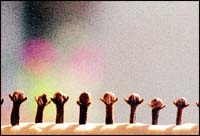


 The Clove Affair!
The Clove Affair!Any dish, be it sweet, meat or rice, without the flavour of cloves is sure to feel incomplete. |
|
Anybody who�s suffered a toothache will tell you that chewing a clove (laung) gives instant relief. Clove oil is an ancient grandmother�s remedy for all kinds of aches and pains. It is also used in the manufacture of perfumes, soaps and as a flavouring agent in medicine and dentistry. But there�s more to cloves than just medicinal use. Richly aromatic, cloves tend to leave a spectrum of sensations on the palate if chewed on their own. Beginning with a sharp tingling, they go on to taste woody and bitter and finally leave the mouth numb and warm. The flavour is so powerful that if too many cloves are used, the other flavours in the dish are completely lost, so they must be used carefully. Nevertheless, cloves are used in cooking the world over... in baked hams, in breads and cakes and even in mulled wine. And in India, cloves are added to rice, meats and sweets. Paan or betel leaf is filled with aromatic spices and sweeteners and held together by a single, whole clove. The word �clove� is derived from the French clou and the English �clout�, both broadly meaning nail, from the likeness of the spice to a large-headed nail. Cloves are one of the most ancient and valuable spices of the Orient. Early references to them can be found in Chinese literature dating back to 266 BC! Good cloves are dark brown in colour. The buds have a long cylindrical base, crowned by a plump, beige ball which is encircled by a four-toothed calyx. Cloves are almost always used whole but they form an important ingredient of blended spice mixtures when ground to a powder. Most people do not actually eat the whole cloves encountered in the finished dish. However, a dish without the flavour of clove is sure to feel incomplete. When buying cloves, look for ones that are rich in colour and have their round crowns intact. Good cloves should leave a trace of oil if pinched hard.
|

Home Page